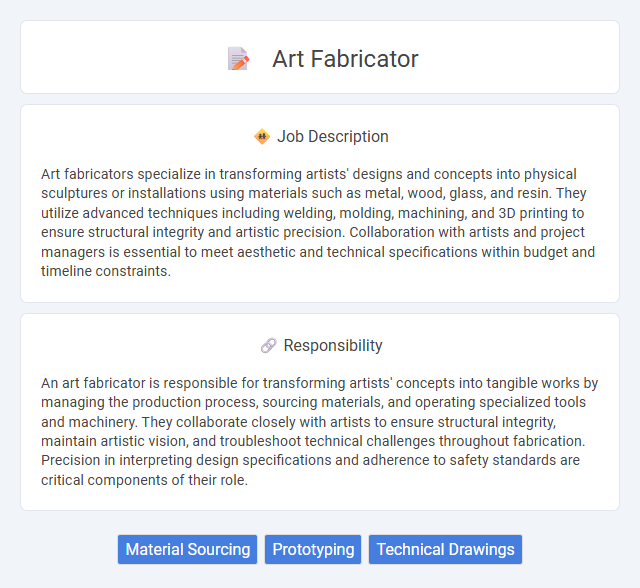
Art fabricators specialize in transforming artists' designs and concepts into physical sculptures or installations using materials such as metal, wood, glass, and resin. They utilize advanced techniques including welding, molding, machining, and 3D printing to ensure structural integrity and artistic precision. Collaboration with artists and project managers is essential to meet aesthetic and technical specifications within budget and timeline constraints.
Those with strong manual dexterity and a passion for creativity are likely to thrive as art fabricators, as the role often involves precise construction and problem-solving under varying conditions. Individuals who prefer repetitive tasks or lack physical stamina might find the demands of the job challenging, given the need to work with diverse materials and equipment. The work environment can be dynamic and sometimes physically demanding, suggesting that candidates comfortable with hands-on, collaborative settings would probably be the best fit.
Qualification
An Art Fabricator requires a strong background in materials science, sculpture, and engineering principles, combined with proficiency in tools and techniques for building large-scale installations. Advanced skills in CAD software, welding, woodworking, and mold-making are essential to transform artistic concepts into durable physical forms. Experience collaborating with artists and project managers, along with knowledge of safety standards and problem-solving abilities, ensures successful fabrication and installation of complex artworks.
Responsibility
An art fabricator is responsible for transforming artists' concepts into tangible works by managing the production process, sourcing materials, and operating specialized tools and machinery. They collaborate closely with artists to ensure structural integrity, maintain artistic vision, and troubleshoot technical challenges throughout fabrication. Precision in interpreting design specifications and adherence to safety standards are critical components of their role.
Benefit
Art fabricators likely gain valuable experience in material manipulation and construction techniques, enhancing their technical skill set. They probably benefit from collaborating with artists and creative teams, which can foster innovative problem-solving abilities. The role may offer opportunities for exposure to diverse artistic styles, potentially expanding their professional network and career prospects.
Challenge
Art fabricator roles likely involve complex problem-solving challenges, requiring the ability to interpret and execute artistic visions with precision. Navigating material limitations and technical constraints may present frequent obstacles, demanding innovative approaches and meticulous attention to detail. The probability of encountering tight deadlines and evolving project specifications could further intensify the complexity of the job.
Career Advancement
Art fabricators specialize in transforming artistic concepts into tangible works using various materials and advanced fabrication techniques. Career advancement in this field often involves gaining expertise in emerging technologies like 3D printing and CNC machining, enhancing project management skills, and building strong networks with galleries and artists. Senior art fabricators or studio managers typically oversee large-scale installations and multidisciplinary teams, leading to roles in creative direction and specialized consultancy.
Key Terms
Material Sourcing
Art fabricators specialize in material sourcing to ensure the highest quality components for sculptures and installations. They collaborate with suppliers to obtain metals, plastics, and specialized textiles that meet precise artistic specifications. Effective material sourcing enhances durability and aesthetic integrity in custom art pieces.
Prototyping
Art fabricators specialize in prototyping by transforming creative concepts into tangible models using advanced materials such as resin, metal, and composites. They employ cutting-edge techniques like 3D printing, CNC machining, and mold-making to create accurate prototypes that maintain the artist's vision and structural integrity. Expertise in prototyping accelerates the development process, allowing for iterative testing and refinement prior to final production.
Technical Drawings
Art fabricators specialize in interpreting technical drawings to accurately reproduce artists' visions into physical forms, ensuring precision and fidelity in materials and dimensions. Mastery of CAD software and proficiency in reading blueprints are essential for translating complex design specifications into executable fabrication plans. This expertise enables seamless collaboration with artists, architects, and engineers, driving the successful realization of sculptural installations and custom art projects.
 kuljobs.com
kuljobs.com